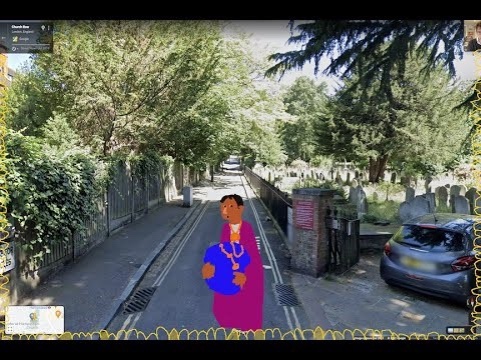Meet the man leading an online pilgrimage across London – and doodling on your neighbourhood using Google Street View

An artist and poet who walked from London to Canterbury via Google Street View during lockdown is inviting you to join him for a YouTube pilgrimage – and some virtual graffitiing all over London.
John-Paul Flintoff is well-known for his online pilgrimages and his use of Google Street View as a canvas upon which to etch exquisite and quirky illustrations. The artist’s latest virtual pilgrimage, which coincides with the publication of his book Psalms for the City – a collection of poetry that celebrates London and the mental healing he found there after a breakdown – takes place on the 3rd November.
Starting with an excursion from North London to Westminster Abbey, Participants will be invited to ‘walk’ with John-Paul all over the UK’s capital, and draw meaningful images onto the city, revealing the hidden treasure of London, the magic of the most seemingly nondescript areas.
Despite turning digital excursions into an art-form, John Paul’s first pilgrimages were offline – and accidental. A former Sunday Times journalist, he suffered a mental breakdown that left him hospitalised, and found himself wandering into empty churches on his way home from therapy sessions (churches – unlike coffee shops – were free). John-Paul found unexpected healing, both through walking, and illustrating the beauty of his home city of London, whose tower-blocks, bus stops, and churches provided such surprising refuge.
When COVID-19 hit, John-Paul took his pilgrimages online – and invited others to join him. He clicked his way past blurred-out faces and car numberplates, and took screengrabs of streets, drawing biblical scene onto these images of modern-day Britain. From his pictures of Abraham about to sacrifice Isaac just outside a dry cleaner in North London, to the haloes he drew around the heads of two women drinking milkshakes at a bus stop in Preston, John-Paul emphasises that holiness and sacred moments are just as appropriate in 21st century urban spaces as they are in ancient religious texts.
“I like the idea that the grotty area behind some bins on an unremarkable street might be the space where something cosmic is, was and ever shall be taking place”, says John-Paul.
Like the work of a modern-day Chaucer, John-Paul’s poetry in Psalms for The City, contains diverse and colourful vignettes of life in 2022. Inspired by the Luttrell Psalter, a book of illustrated psalms from the late Middle Ages, which includes marginal images showing everyday life from that period, Psalms for The City contains John Paul’s own marginal drawings of urban life in 2022 alongside his psalms, like a modern-day medieval manuscript.
Born out of John-Paul’s recovery from a metal breakdown, Psalms for The City is a love-song to our cities, to the relationship between poetry and prayer, and the fact that we are all beings with spiritual health that deserves tending to.
John-Paul’s virtual pilgrimage will take place on the 3rd November at 7pm, and you can access the link to join here: 21st Century Psalter | YouTube Livestream | Make Art With John-Paul Flintoff. Participants can use online drawing app Aggie.io to draw collaboratively with John-Paul – no download required.






